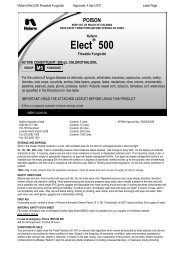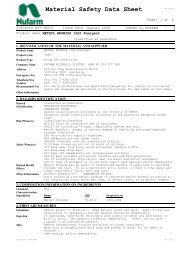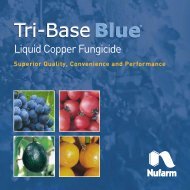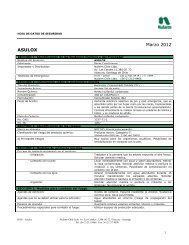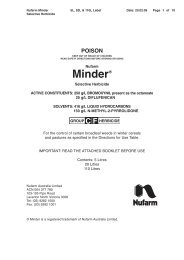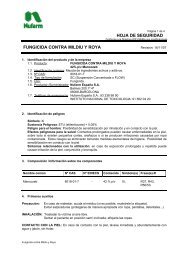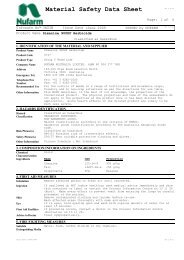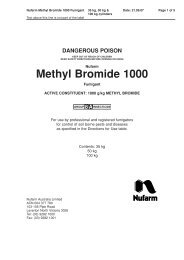Adjuvants Product Guide. MOF 8048 07/02 - Nufarm
Adjuvants Product Guide. MOF 8048 07/02 - Nufarm
Adjuvants Product Guide. MOF 8048 07/02 - Nufarm
Create successful ePaper yourself
Turn your PDF publications into a flip-book with our unique Google optimized e-Paper software.
ADJUVANTS<br />
PRODUCT GUIDE
Contents<br />
Introduction<br />
INTRODUCTION 1<br />
IMPROVE COVERAGE<br />
Activator* Surfactant 6<br />
Chemwet* 1000 Surfactant 8<br />
Pulse Penetrant 10<br />
Wetter TX Surfactant 12<br />
MINIMISE LOSSES<br />
Bond* Adjuvant 16<br />
LI-700* Acidifing Surfactant 18<br />
Liase* Water Conditioning Agent 20<br />
ENHANCE PENETRATION<br />
LI-700* Penetrating Surfactant 24<br />
Primabuff 26<br />
Pulse Penetrant 28<br />
FEEDING ATTRACTANT<br />
Mobait 30<br />
GENERAL PRODUCTS<br />
Foam Marker* 32<br />
Spray Marker Dye* 34<br />
Tank & Equipment Cleaner* 35<br />
* Spraymate Trade Marks<br />
<strong>Adjuvants</strong> are a unique group of products that<br />
have the ability to greatly influence the performance<br />
of pesticides.<br />
The use of adjuvants as management tools for<br />
agricultural chemicals can modify spray<br />
solutions by:<br />
> improving the physical characteristics,<br />
> reducing or minimizing chemical losses, and<br />
> maximising efficacy by enhancing penetration<br />
The performance of herbicides, fungicides and<br />
insecticides can be affected by a number of variables.<br />
These include:<br />
> The environmental conditions at the time of<br />
application such as temperature, humidity<br />
and rainfall.<br />
> The properties of the water used for mixing such<br />
as pH and hardness.<br />
> The use of tank mixtures of different products<br />
which may effect efficacy and compatibility.<br />
> The condition of the target surface to be sprayed,<br />
for example, leaf surface texture, plant stress,<br />
insect growth stage, soil tilth and type.<br />
<strong>Adjuvants</strong> maximise product efficacy when conditions<br />
are less than ideal, when low<br />
spray volumes are used, or when product performance<br />
needs to be modified or improved.<br />
Adjuvant functionality and 'effect'<br />
The functionality of an adjuvant is determined by its<br />
properties. The properties are determined by the<br />
design of the formulation. Functionality is specifically<br />
determined by the chemistry of the components, the<br />
proportions of the components and, the dose or<br />
quantity used.<br />
1
Introduction continued<br />
Response / % Control<br />
Obtaining an 'effect' from the use of an adjuvant with<br />
an agricultural chemical will depend on what adjuvant<br />
property is added and in what amount, what pesticide<br />
is used and in what amount, the intended target,<br />
application efficacy and environmental conditions.<br />
The graph below represents the dose responsive<br />
nature of the pesticide and pesticide/adjuvant<br />
combination. Note that the adjuvant 'effect' is inversely<br />
related to the pesticide dose. That is, a greater effect<br />
will be observed at lower rates. The 'effect' of the<br />
adjuvant can be represented by the difference<br />
between the two lines.<br />
90<br />
80<br />
70<br />
60<br />
50<br />
40<br />
30<br />
20<br />
10<br />
Typical Responce Curve of Agrichemical<br />
with and without adjuvant<br />
0 0.2 0.5 1x 1.4 2x<br />
Agrichemical Rate<br />
= With Adjuvant<br />
= Without Adjuvant<br />
illustrations of surfactant molecules are usually<br />
represented as follows:<br />
Head<br />
Tail<br />
When surfactants are mixed with water, the 'head'<br />
portion attaches itself to water molecules. Due to the<br />
polar nature of both the 'head' and the water molecule,<br />
surface tension of the water is reduced (depending on<br />
concentration of the surfactant). Reduction will be<br />
non-linear until a maximum depression is achieved.<br />
Beyond this point, the addition of more surfactant<br />
does not result in further reduction of surface tension.<br />
Surfactants will cause droplets to collapse under their<br />
own weight and dramatically increase the area of<br />
contact. This is one of the main reasons surfactants<br />
are used with pesticides to improve physical coverage<br />
over the surface of the intended target.<br />
The following diagram illustrates the effect that<br />
surfactant has on reducing the surface tension of<br />
spray volume droplets<br />
Surfactant properties and behaviour<br />
The single most common unique feature of a<br />
surfactant is not its chemistry, but its two-part<br />
structure. Every surfactant molecule will have a<br />
distinct portion that is to some degree, water soluble<br />
(hydrophilic), and a portion that is also to some<br />
degree, oil soluble (lipophilic). It is this dual set of<br />
diverse properties that will determine the surfactant's<br />
behaviour and functionality. General pictorial<br />
Without Surfactant<br />
With Surfactant<br />
2<br />
3
Improve<br />
Coverage<br />
Slender shiny leaf surfaces, hairy or<br />
waxy leaves and rainfall soon after<br />
spraying all contribute to poor coverage<br />
of spray droplets.<br />
'Beading' of individual droplets on leaf<br />
surfaces means lack of contact area,<br />
which can translate to lower control<br />
levels from pesticides.<br />
The solution is to reduce surface tension<br />
by using an adjuvant that:<br />
> makes spray droplets lie down or<br />
collapse to cover a wider area<br />
> assists entry of pesticides into<br />
target sites<br />
4<br />
5
Improve coverage<br />
SPRAYMATE TM Spraymate Activator increased herbicide effectiveness by up to 42%<br />
ACTIVATOR<br />
Active constituent: 900 g/L Non-ionic surfactants<br />
Spraymate Activator is a high quality wetting agent for<br />
use wherever a non-ionic surfactant is recommended<br />
on pesticide labels.<br />
Spraymate Activator works by reducing the surface<br />
tension of the spray solution. This causes droplets to<br />
spread out evenly when they reach the target.<br />
Ingredients in Spraymate Activator also act on the leaf<br />
surface to increase chemical uptake.<br />
Spraymate Activator contains an anti-foaming agent,<br />
so with less foam generated, together with Spraymate<br />
Activator's biodegradable active ingredients, it's safe<br />
to use and won't harm the environment.<br />
The practice of comparing application costs based<br />
on percentage dilution only assumes all wetters have<br />
the same active ingredient, but they don't. The high<br />
quality ingredients in Spraymate Activator means it<br />
can be used at lower rates than most other<br />
surfactants, therefore the application cost is likely to<br />
be lower than with similar products.<br />
Key benefits<br />
> Increases coverage and improves uptake<br />
> Improves performance of Nugrass for<br />
Annual ryegrass control<br />
> Reduces foaming of Nu-trazine Flowable herbicide<br />
> Improves performance of foliar<br />
fungicides - particularly systemics<br />
> Low foaming and biodegradable<br />
> Low application rates<br />
Annual Ryegrass Weed Count<br />
% Weed Control<br />
18<br />
16<br />
14<br />
12<br />
10<br />
8<br />
6<br />
4<br />
2<br />
Effect of Spraymate Activator Surfactant on<br />
Annual Ryegrass control with Nugrass ®<br />
18<br />
(51 days after treatment)<br />
0<br />
Without Spraymate Activator<br />
With 0.125% Spraymate Activator<br />
0<br />
Nugrass 0.5 L/ha<br />
Nugrass 0.75 L/ha<br />
Spraymate Activator increased herbicide effectiveness by 100%<br />
90<br />
80<br />
70<br />
60<br />
50<br />
40<br />
30<br />
20<br />
10<br />
0<br />
Chlorsulfuron (e.g. LUSTA)<br />
Climbing Buckwheat<br />
Source: SA Dept of Ag (1998)<br />
Effect of Spraymate Activator Surfactant on Climbing<br />
Buckwheat & thistle control with Chlorsulfuron<br />
(60 days after treatment) Source: DuPont USA<br />
65<br />
8<br />
(e.g. LUSTA) + Spraymate Activator<br />
85 85<br />
60<br />
Thistles<br />
0<br />
6 Packaging: 10 L and 5 L<br />
7
Improve coverage<br />
SPRAYMATE TM Spraymate Chemwet 1000 increased herbicide effectiveness by 45%<br />
CHEMWET 1000<br />
Active constituent: 1,000 g/L non-ionic ethoxylates<br />
Spraymate Chemwet 1000 is a high quality,<br />
concentrated adjuvant formulation that contains a<br />
100% non-ionic surfactant. Spraymate Chemwet 1000<br />
is an excellent general purpose surfactant for use with<br />
most classes of agricultural chemicals.<br />
Spraymate Chemwet 1000 reduces surface tension of<br />
the spray solution and improves wetting and<br />
spreading on waxy leaf surfaces. At high rates<br />
Spraymate Chemwet 1000 can also aid in the uptake<br />
of systemic herbicides such as glyphosate.<br />
Spraymate Chemwet 1000 is highly concentrated.<br />
Not all non-ionic surfactants on the market are<br />
highly concentrated, with some containing as little<br />
as 200 g/L active ingredient. It is important to consider<br />
the quality of these formulations when choosing a<br />
surfactant product.<br />
Key benefits<br />
> Excellent general purpose surfactant<br />
> Highly concentrated formulation<br />
> Wide range of applications<br />
> Acts as a penetrant at high rates<br />
Mean Fresh Weight<br />
0.14<br />
0.12<br />
0.1<br />
0.08<br />
0.06<br />
0.04<br />
0.<strong>02</strong><br />
0<br />
Effect of Spraymate Chemwet 1000 with<br />
Glyphosate CT on the Fresh Weight of Annual<br />
Ryegrass Foliage (14 days after treatment)<br />
0.124<br />
Source: Eureka! Research 2000<br />
0.069<br />
Glyphosate CT Glyphosate CT +<br />
Chemwet 1000 at 0.2%<br />
Resistant Annual ryegrass in a cereal crop<br />
8<br />
Packaging: 20 L and 5 L<br />
9
Improve coverage<br />
PULSE ®<br />
PENETRANT<br />
Active constituent: 1,000 g/L Modified polydimethylsiloxane<br />
Water plus standard non-ionic wetter 0.2%<br />
Pulse is a non-ionic organosilicone super wetter<br />
and is widely recognized as a penetrant for use<br />
with glyphosate products to enhance penetration<br />
of woody weeds. However, the excellent spreading<br />
characteristics of Pulse make it extremely suitable<br />
for use with other agricultural chemicals* including<br />
fungicides, insecticides, miticides and foliar<br />
micro-nutrients.<br />
Pulse works by decreasing the surface tension of<br />
spray droplets so much, that the entire leaf surface<br />
can be wet by a small amount of spray solution. This<br />
greatly increases coverage, improves wetting of waxy<br />
leaves such as cabbages and gets to difficult-to-reach<br />
target sites in various crops.<br />
The very low surface tensions produced with Pulse<br />
results in stomatal flooding which can not be achieved<br />
with normal non-ionic surfactants. This allows uptake<br />
of systemic pesticides through stomata and<br />
improves rainfastness.<br />
Key benefits<br />
> Excellent spreading characteristics<br />
> Ensures pesticide uptake<br />
> Enhances efficacy of Confidor ® in cotton<br />
> Improves rainfastness<br />
* Registration pending at time of print<br />
Water plus Pulse Penetrant 0.2%<br />
Pulse improves the spread of water drops<br />
on leaves by up to 13 times.<br />
QUALIFYING PRODUCT<br />
Adapted from ”Effect of a new organo-silicone surfactant on<br />
droplet spread” J.Vitelli, Eighth Australian Weed Conference, 1987.<br />
(Droplets are shown larger than actual size.)<br />
10<br />
Packaging: 5 L, 1 L and 100 mL 11
Improve coverage<br />
WETTER TX<br />
Active constituent: 1,040 g/L Octyl phenol ethoxylate<br />
Wetter TX is a special purpose non-ionic surfactant.<br />
It's recommended for addition to various Roundup ®<br />
formulations to improve control of certain grass<br />
weeds - Annual ryegrass, Silver grass, certain<br />
perennial grasses and Serrated tussock.<br />
A common use for Wetter TX is when Annual ryegrass<br />
is present. Annual ryegrass grows prolifically from<br />
autumn until early winter - when tillering occurs. In<br />
mid-winter, Annual ryegrass generally grows slowly<br />
due to short daylight hours and low temperatures.<br />
In spring warmer temperatures initiate a period of<br />
rapid growth. This is refered to as ‘Phasic growth’ and<br />
can vary from season to season.<br />
As Annual ryegrass develops, the cuticle thickens and<br />
becomes more waxy. This combination of waxy cuticle<br />
and ‘Phasic growth’ has made stand-alone treatment<br />
with glyphosate often ineffective. Wetter TX has been<br />
proven to give reliable control of these harder-to-kill<br />
grasses in spring by enabling more efficient entry of<br />
Roundup ® into the plant.<br />
Key benefits<br />
> Improves spray droplet coverage and penetration<br />
through waxy leaf surfaces<br />
> Ensures optimum Roundup ® performance on<br />
Annual ryegrass and Silver grass in spring<br />
> Ensure optimum Roundup ®<br />
performance on certain<br />
perennial grasses such as<br />
phalaris and couch<br />
The following table indicates where Wetter TX is<br />
recommended with various Roundup ® formulations.<br />
Always read the Roundup ® label for full instructions<br />
and directions for use.<br />
Roundup ®<br />
Roundup ®<br />
CT<br />
Roundup ®<br />
Biactive TM<br />
Roundup ®<br />
MAX<br />
Roundup ®<br />
Dry<br />
*Annual<br />
ryegrass<br />
✓<br />
✓<br />
✓<br />
✓<br />
✓<br />
*Silver<br />
grass<br />
✓<br />
✓<br />
✓<br />
✓<br />
✓<br />
* Spring (from beginning of August to October).<br />
QUALIFYING PRODUCT<br />
Perennial<br />
grasses<br />
✓<br />
✓<br />
✓<br />
✓<br />
✓<br />
Serrated<br />
tussock<br />
✓<br />
✓<br />
12<br />
Packaging: 5 L<br />
13
Minimise<br />
Losses<br />
Natural phenomena such as temperature,<br />
moisture, sunlight, wind, and rainfall<br />
impact upon the degradation and<br />
adherence of spray droplets. Losses<br />
also occur through poor water quality<br />
(hardness and high pH), weed stress,<br />
or compatibility problems.<br />
Extremes of natural phenomena,<br />
lack of adherence to repellant leaf<br />
surfaces, and the breakdown of pesticides,<br />
can translate to physical loss and reduced<br />
effectiveness.<br />
The solution is to minimize losses by using<br />
an adjuvant that:<br />
> protects droplets from the elements, or<br />
> is capable of sticking droplets firmly to<br />
leaves, or<br />
> minimizes the effect of cationic metals in<br />
water, or<br />
> lowers the pH of spray water in the tank<br />
before mixing, or<br />
> reduces antagonism, or<br />
> manages droplet size<br />
14<br />
15
Minimise Losses<br />
SPRAYMATE TM Spraymate Bond increased fungicide effectiveness by up to 41%<br />
BOND<br />
Active constituents: 450 g/L Synthetic latex, 100 g/L Surfactant<br />
Spraymate Bond is a high quality sticker, deposition<br />
and retention agent for use with contact or protectant<br />
type fungicides or with contact and ingested<br />
insecticides.<br />
The elastic properties of Spraymate Bond act to<br />
absorb the energy from spray droplets as they impact<br />
on the target. This improves spray droplet deposition<br />
through less shatter, bounce and runoff.<br />
Spraymate Bond increases adherence of spray<br />
droplets by sticking them firmly to target surfaces.<br />
This protects pesticides against wash-off by rain or<br />
sprinkler irrigation, but Spraymate Bond does not<br />
encapsulate the droplet, so it enables maximum<br />
chemical activity over the leaf area. This is a<br />
considerable improvement over standard wetting<br />
agents.<br />
Spraymate Bond also protects chemicals by slowing<br />
the rate of degradation immediately after application,<br />
however it does not extend the life of products beyond<br />
recommended maximum residue limits, therefore it<br />
does not change established withholding periods.<br />
Key benefits<br />
> Improves spray droplet deposition<br />
> Retains and protects droplets on targets<br />
> Improves the performance and life<br />
of protectant fungicides and<br />
contact insecticides<br />
% Leaves infected<br />
30<br />
25<br />
20<br />
15<br />
10<br />
5<br />
0<br />
Penncozeb ® 750 DF<br />
Effect of Spraymate Bond<br />
on Mancozeb Rainfastness<br />
3 4<br />
Mancozeb<br />
Nil<br />
Penncozeb ® 750 DF+Spraymate Bond<br />
25<br />
Amount of Rainfall<br />
Mancozeb<br />
+ Spraymate Bond<br />
12<br />
7<br />
25 mm<br />
25<br />
Untreated<br />
Source: Eureka! Research 2001<br />
Ascochyta control in Chickpeas<br />
Inoculated<br />
Untreated control<br />
16<br />
Packaging: 10 L and 5 L<br />
17
Minimise Losses<br />
SPRAYMATE TM<br />
LI-700<br />
Active constituent: 350 g/L Soyal phospholipids, 350 g/L Propionic acid<br />
Under certain conditions, some agricultural chemicals<br />
are prone to alkaline hydrolysis - a phenomenon that<br />
results in the irreversible destruction of the active<br />
ingredient in alkaline spray solutions.<br />
Spraymate LI-700 is a unique multi-purpose<br />
adjuvant. It decreases the pH of spray solutions,<br />
making them more acidic. This prevents losses<br />
when using pesticides that are susceptible to<br />
breakdown by 'alkaline hydrolysis'.<br />
The effect of individual adjuvants on droplet size<br />
can be unpredictable. Often this can lead to the<br />
production of more driftable fine droplets as is<br />
seen with standard non-ionic surfactants.<br />
Research conducted at Centre for Pesticide<br />
Application and Safety in Queensland has shown<br />
that Spraymate LI-700 will reduce the number of<br />
fine droplets produced when mixed with glyphosate,<br />
compared to glyphosate alone. This means that<br />
Spraymate LI-700 is the ideal adjuvant to use where<br />
spray drift is a concern.<br />
Key benefits<br />
> Manages losses caused by alkaline hydrolysis<br />
> Improves uptake of weak acid herbicides<br />
(e.g. glyphosate)<br />
> Produces fewer driftable droplets<br />
Hours<br />
Mean Droplet Size µm D (v,0.1)<br />
25<br />
20<br />
15<br />
10<br />
5<br />
0<br />
100<br />
75<br />
25<br />
0<br />
Effect of pH on half-life in hours of Dimethoate<br />
pH 4<br />
pH 6 ph 9<br />
With a half-life of only 48 minutes, Dimethoate loss<br />
is rapid in alkaline spray water (pH 9)<br />
Effect of Spraymate LI-700 on Mean Droplet<br />
Size when mixed with Glyphosate CT<br />
93<br />
Glyphosate CT<br />
+ LI-700<br />
85<br />
Glyphosate CT<br />
Source: University of Qld<br />
79<br />
Glyphosate CT +<br />
Standard Non-ionic<br />
Surfactant<br />
Spraymate LI-700 increased average droplet size and<br />
minimised the potential for physical spray drift<br />
QUALIFYING PRODUCT<br />
18<br />
Packaging: 20 L, 10 L and 5 L<br />
19
Minimise Losses<br />
LIASE<br />
Active constituents: 417 g/L Ammonium sulfate<br />
Spraymate Liase is a high quality aqueous solution of<br />
ammonium sulphate which is used to reduce<br />
antagonism with glyphosate under certain conditions.<br />
Spraymate Liase should be added to glyphosate<br />
spray mixtures if the water being used contains<br />
magnesium, calcium or other cationic metals which<br />
make the water hard. If total water hardness is 250<br />
ppm or more, then Spraymate Liase should be used.<br />
When using Spraymate Liase, always add it to the<br />
water before anything else. If in doubt about water<br />
quality, take a sample and have it tested for total<br />
hardness and pH.<br />
Spraymate Liase is also recommended in glyphosate<br />
tank mixtures with other herbicides especially SC and<br />
DF formulations such as atrazine, diuron and<br />
simazine, and when target weeds are under stress<br />
due to adverse conditions.<br />
Key benefits<br />
> Minimises the impact of hard water<br />
on glyphosate performance<br />
> Minimises antagonism between<br />
glyphosate and other herbicides<br />
> Improves glyphosate performance<br />
when weeds are stressed<br />
%Wild Oat Control @ 26 DAT<br />
100<br />
90<br />
80<br />
70<br />
60<br />
50<br />
40<br />
30<br />
20<br />
10<br />
0<br />
Effect of Spraymate Liase in minimising<br />
Glyphosate CT and Nu-trazine antagonism<br />
Source: <strong>Nufarm</strong> 1998<br />
66.25<br />
Glyphosate CT + Nu-trazine<br />
1.6 kg<br />
97.5<br />
Glyphosate CT + Nu-trazine<br />
1.6 kg + Liase<br />
SPRAYMATE TM Spraymate Liase increased herbicide mixture effectiveness by 45%<br />
Liase minimizes antagonism of Glyphosate CT + Nu-trazine to<br />
ensure effective weed control.<br />
20<br />
Packaging: 20 L<br />
21
Enhance<br />
Penetration<br />
Herbicides must get past protective<br />
barriers in plants to be truly effective.<br />
Targets which have waxy, oily or hairy<br />
leaf surfaces, along with thick leaf<br />
cuticles or woody stems, can slow<br />
or resist penetration.<br />
Difficult to penetrate barriers can translate<br />
to lower control levels and/or reduced<br />
uptake of foliar applied nutrients.<br />
The solution is to enhance penetration by<br />
using an adjuvant that:<br />
> has good properties of solvency and<br />
water affinity, or<br />
> has superior spreading characteristics<br />
and actives capable of forcing entry<br />
into plants<br />
22 23
Enhance Penetration<br />
LI-700<br />
Active constituent: 350 g/L Soyal phospholipids, 350 g/L Propionic acid<br />
The unique attributes of Spraymate LI-700 are further<br />
illustrated by its ability to enhance penetration of<br />
herbicides and foliar fertilizers.<br />
Spraymate LI-700 acts as an excellent penetrant for<br />
use with weak acid herbicides. It works in two key<br />
ways by reducing the pH of the spray solution it<br />
modifies the herbicide to become non-ionised. This<br />
form of the herbicide passes through plant cuticles<br />
more readily, resulting in faster uptake. The nonionised<br />
form of the herbicide is also less susceptible<br />
to antagonism by cations found in hard water such<br />
as calcium and magnesium.<br />
Spraymate LI-700 is composed of soyal<br />
phospholipids, these are natural surfactants found in<br />
plant cell membranes, at high rates these surfactants<br />
act on the waxy plant surfaces and decrease their<br />
resistance to aqueous herbicide solutions.<br />
For foliar nutrients to be effective, they have to be<br />
absorbed through the leaf cuticle. Trials show that<br />
Spraymate LI-700 enhances the uptake by the plant<br />
of foliar nutrients, such as zinc, manganese, nitrogen,<br />
potassium, and phosphorus.<br />
Key benefits<br />
> Enhances penetration of herbicides<br />
and foliar fertilisers<br />
QUALIFYING PRODUCT<br />
% Improvement<br />
Yield (T/Ha)<br />
20<br />
18<br />
16<br />
14<br />
12<br />
10<br />
8<br />
6<br />
4<br />
2<br />
Effect of Spraymate LI-700 on the<br />
Performance of Glyphosate CT<br />
(water pH 9, total hardness 1000 ppm)<br />
Source: <strong>Nufarm</strong> 1999<br />
0<br />
0 Glyphosate CT Glyphosate CT Glyphosate CT<br />
+LI-700 +Liase<br />
3.5<br />
3.4<br />
3.3<br />
3.2<br />
3.1<br />
3<br />
16 16<br />
Effect of Spraymate LI-700 with Foliar<br />
Fertiliers on Wheat Yield Responses<br />
Source: <strong>Nufarm</strong> 1999<br />
3.16<br />
No Fertiliser<br />
3.3<br />
Zintrac 350 mL/Ha<br />
+ Supa-N-32<br />
2 L/100 L<br />
19<br />
Glyphosate CT<br />
+Liase+LI-700<br />
3.48<br />
Zintrac 350 mL/Ha<br />
+ Supa-N-32 2 L/100 L<br />
+ LI-700 200 mL/100 L<br />
Spraymate LI-700 with foliar fertilisers increased yield by up to 10%<br />
SPRAYMATE TM Spraymate LI-700 increased herbicide effectiveness by 16%<br />
24<br />
Packaging: 20 L, 10 L and 5 L<br />
25
Enhance Penetration<br />
PRIMABUFF<br />
Active constituent: 255.7 g/L Anionic components,<br />
322.3 g/L Non-ionic components<br />
Primabuff BB5 has been specifically developed as a<br />
multi-functioning spray adjuvant, designed to cater for<br />
a wide variability in spray water quality.<br />
Primabuff BB5 contains a pH colour indicator with a<br />
built-in logic that monitors the pH of the spray<br />
solution. A colour change reaction will confirm<br />
whether sufficient adjuvant has been added to the<br />
spray water, and when the optimal pH level has been<br />
reached. The colour of the spray water will<br />
automatically change to pink/red (dependant on water<br />
hardness) once the optimal pH range of 4.5 to 5.5 has<br />
been reached. This unique feature eliminates the<br />
necessity to repeatedly check either the water<br />
hardness or the pH with specialist equipment.<br />
Primabuff BB5 is also useful for buffering spray<br />
solutions to pH 4 so that the uptake of gibberellic acid<br />
into citrus fruits is improved. This can help prevent<br />
rind creasing and softening disorder.<br />
Key benefits<br />
> Built-in colour indicator determines optimum pH<br />
level of spray solution<br />
> Enhances performance of Gibberellic acid in<br />
citrus and vines<br />
Soft Water<br />
Hard Water<br />
Colour and pH reaction in water to<br />
increasing rates of Primabuff BB5<br />
Primabuff BB5 is the preferred adjuvant for use with Pro-Gibb ®<br />
Gibberellic Acid (GA3)<br />
26<br />
Packaging: 20 L<br />
27
Enhance Penetration<br />
PULSE ®<br />
PENETRANT<br />
Active constituent: 1,000 g/L Modified polydimethylsiloxane<br />
Pulse is an incredibly effective organosilicone-based<br />
spray additive. This technology dramatically reduces<br />
surface tension to allow maximum spreading of spray<br />
droplets on plant surfaces. Pulse is so effective, it<br />
improves the spread of spray droplets on leaves by<br />
up to 13 times.<br />
This superior coverage allows thorough penetration<br />
and translocation of certain herbicides used for hardto-control<br />
brush and woody weeds. Pulse is suitable<br />
for use where pesticide labels recommend the<br />
addition of an organosilicone surfactant e.g. Trounce ®<br />
Brush-Pack TM when treating Blackberry, Bracken,<br />
Gorse, Lantana, St John's wort and Sweet briar;<br />
glyphosate (Roundup ® , Weedmaster ® Duo), and<br />
metsulfuron methyl herbicides (Brushkiller ® 600)<br />
when treating certain unwanted eucalyptus species,<br />
Bracken, Gorse and Lantana.<br />
Trial work has also demonstrated that Pulse will<br />
improved Roundup ® penetration significantly (10-fold),<br />
and increase translocation (almost four times) of a<br />
greater percentage of the applied Roundup ® .<br />
Key benefits<br />
> Superior spreading characteristics<br />
> Better penetration of plant tissue<br />
> Increases translocation within plants<br />
QUALIFYING PRODUCT<br />
% Control<br />
% Control<br />
100<br />
90<br />
80<br />
70<br />
60<br />
50<br />
40<br />
30<br />
20<br />
10<br />
Effect of Pulse Penetrant with Roundup ®<br />
for control of Bitou Bush<br />
Source: NSW Ag<br />
20<br />
0<br />
Roundup<br />
Roundup + Pulse<br />
Pulse increased effectiveness on hard-to-kill Bitou Bush by 390%<br />
100<br />
90<br />
80<br />
70<br />
60<br />
50<br />
40<br />
30<br />
20<br />
10<br />
Effect of Pulse Penetrant with Brushkiller 600<br />
for control of Bitou Bush<br />
Source: NSW Ag<br />
65<br />
0<br />
Brushkiller 600<br />
Brushkiller 600 + Pulse<br />
Pulse increased effectiveness on hard-to-kill Bitou Bush by 54%<br />
98<br />
100<br />
28<br />
Packaging: 5 L, 1 L and 200 mL<br />
29
Feeding Attractant<br />
MOBAIT ®<br />
Active constituent: 265 g/L Food flavourings<br />
Mobait is an insecticide spray additive that contains a<br />
unique blend of natural food extracts. Mobait imitates<br />
the high sugar and protein foods insect larvae are<br />
attracted to. Making insecticides attractive to insect<br />
pests will improve performance.<br />
The primary function of Mobait is to improve the<br />
acceptance of insecticides by insects. This is<br />
particularly useful for many of the 'soft' IPM products<br />
used these days, which have to be ingested to<br />
work effectively.<br />
Mobait encourages feeding on sprayed leaves and<br />
results in a greater dose of insecticide being taken. It<br />
also encourages larvae (which are hidden in sheltered<br />
feeding sites such as flowers and bunches) to move<br />
onto sprayed surfaces to feed. This can help control<br />
entrenched larvae which are very difficult to control<br />
under normal conditions.<br />
Key benefits<br />
> Attracts insects to sprayed surfaces<br />
> Encourages insects to ingest insecticide<br />
> Encourages larvae to move from<br />
sheltered areas and ingest insecticide<br />
> Improves efficacy of Bt’s for Light Brown Apple<br />
Moth control in grapes<br />
Heliothis Larvae Per Metre Row<br />
Average No. of Larvae Per Panel<br />
6<br />
5<br />
4<br />
3<br />
2<br />
1<br />
0<br />
45<br />
40<br />
35<br />
30<br />
25<br />
20<br />
15<br />
10<br />
5<br />
0<br />
Mobait + Steward ® in Cotton<br />
(9 days after treatment)<br />
5.9<br />
2.8<br />
Untreated<br />
Steward Steward + Mobait<br />
Mobait improved Steward efficacy in cotton by 28%<br />
Control of Light Brown Apple Moth in Grapes<br />
41<br />
15<br />
1-2 instar<br />
5 DAT<br />
21<br />
9<br />
1-2 instar<br />
12 DAT<br />
Source: Replicated field trial, Phytech Kununurra<br />
Bunch larvae<br />
5 DAT<br />
2.0<br />
Source: M. Dixon, Wesfarmers Landmark, Penola, S.A.<br />
Dipel ®<br />
Dipel ® + 125 mL Mobait<br />
8 7<br />
0 0<br />
Mobait improved Dipel efficacy by up to 100%<br />
Bunch larvae<br />
12 DAT<br />
30<br />
Packaging: 10 L and 5 L<br />
31
General <strong>Product</strong>s<br />
SPRAYMATE TM<br />
FOAM MARKER<br />
Active constituent: 683 g/L Foaming agent<br />
When using foam markers it is important to consider a<br />
number of factors that influence foam quality and<br />
survival. The single biggest influence on foam life is<br />
the temperature of the soil or vegetation onto which<br />
they are sprayed. In high temperatures foam life can<br />
be reduced especially on bare soil and in windy<br />
conditions. Foam quality and survival are also reduced<br />
when using hard water, or cold water to dilute the<br />
concentrate with.<br />
<strong>Nufarm</strong> has recently developed new improved<br />
formulations for red and white foam marker. An<br />
independent foam specialist evaluated these as the<br />
best in their class for foam quality, hard water stability,<br />
and cold water stability. All three formulations<br />
produced excellent foam at 2000 ppm hardness and<br />
at water temperatures of 6 o C. Tests were also carried<br />
out on foam survival showing foam life greater than<br />
one hour on soil and grass with surface temperatures<br />
between 31 o C and 44 o C.<br />
Key benefits<br />
> A unique high quality blend of foaming surfactants<br />
and foam stabilizers<br />
> Excellent cold and hard water stability<br />
> Long life even on hot soil<br />
> Available as white or red<br />
Mean blob Size (L)<br />
Number of Blobs<br />
2.5<br />
2.4<br />
2.3<br />
2.2<br />
2.1<br />
2.0<br />
1.9<br />
1.8<br />
Effect of cold water on mean blob size<br />
2.1<br />
2.4<br />
Rainwater 6 to 7ºC Rainwater 17 to 18ºC<br />
Effect of hard water (500 ppm Ca Co 3 ) on<br />
the mean number of blobs produced<br />
13 Source: Spray Smart Enterprises 2001<br />
12<br />
11<br />
10<br />
10.8<br />
Other white foam<br />
<strong>Nufarm</strong> white foam<br />
Source: Spray Smart Enterprises 2001<br />
2.0<br />
2.1<br />
Other white foam<br />
<strong>Nufarm</strong> white foam<br />
Other red foam<br />
<strong>Nufarm</strong> red foam<br />
2.5<br />
2.0<br />
Other red foam<br />
<strong>Nufarm</strong> red foam<br />
12.3 12.3<br />
11.8<br />
2.1 2.1<br />
32<br />
Packaging: 20 L and 5 L<br />
33
General <strong>Product</strong>s<br />
SPRAYMATE TM<br />
SPRAY MARKER DYE<br />
Active constituent: 150 g/L Rhodamine B<br />
Spraymate Spray Marker Dye is a red liquid dye<br />
to assist in the identification of areas sprayed with<br />
herbicides. Spraymate Spray Marker Dye is suitable<br />
for use with most formulations of agricultural<br />
chemicals, whether they be liquid, granular or<br />
powder products.<br />
Key benefits<br />
> Eliminates wastage by preventing double spraying<br />
> Can be used as a foam colouring agent in<br />
broadacre situations to indicate swath width<br />
> Saves time and money<br />
SPRAYMATE TM<br />
T&E CLEANER<br />
Active constituent: Sodium tripolyphosphate and industrial detergents<br />
Small amounts of pesticide, which are safe to one<br />
crop, may be seriously damaging to another herbicide<br />
(e.g. Sulfoylureas such as Associate ® , or grass<br />
selective herbicides such as Asset ® - Haloxyfop).<br />
Frequent use of sprayers and changes of pesticide<br />
type means residues and contamination are a real<br />
threat to crop safety. Sprayers must be thoroughly<br />
cleaned when changing from one pesticide type<br />
to another.<br />
Spraymate Tank & Equipment Cleaner is a mixture<br />
of powerful detergents, specifically designed to meet<br />
the demands of cleaning modern sprayers. The strong<br />
flushing action removes residues from non-accessible<br />
areas in the tank and spray lines. It also removes rust<br />
and hard water scale, and will leave a protective film<br />
to prevent corrosion during storage. Even if<br />
equipment is not subject to corrosion, the removal<br />
of minerals deposited by water can keep sprayers<br />
working longer.<br />
Key benefits<br />
> Powerful blend of industrial detergents<br />
> Removes rust, hard water scale, and assists in<br />
removing residues and stains<br />
> Prevents corrosion during storage<br />
34 Packaging: 5 L and 1 L Packaging: 1 kg<br />
35
Notes<br />
® Registered Trade Marks<br />
Pulse is a registered trade mark of <strong>Nufarm</strong> Americas, Inc.<br />
Associate, Brushkiller, Mobait, Nugrass, and Weedmaster are registered trade marks<br />
of <strong>Nufarm</strong> Australia Limited.<br />
Trounce & Roundup are registered trade marks of Monsanto Company LLC.<br />
TM<br />
Trade Marks<br />
Brush-Pack is a trade mark of Monsanto Company LLC.<br />
Spraymate is a trade mark of Loveland Industries, Greeley, Colorado, USA.<br />
All other brand names are trade marks or registered trade marks of their repective owners.<br />
<strong>8048</strong> <strong>07</strong>/<strong>02</strong><br />
36<br />
37



